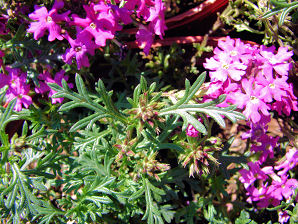Xeriscape Landscaping Plants For The Arizona Desert Environment.
Pictures, Photos, Information, Descriptions,
Images, & Reviews.
Perennials.
Peruvian Verbena, Glandularia peruviana.
We Are Proud Of Our SafeSurf Rating!
Click On Any Of The Following Links By Amazon.Com
For Books, & Videos About Wildflowers Of Arizona & The Southwest USA. No Obligation!
| Peruvian Verbena, Glandularia peruviana. Pink Variety. Photos Taken March 10, 2008. Glendale, Arizona. |
|---|
 |  |
| Peruvian Verbena Leaves. Glandularia peruviana. | Peruvian Verbena Flowers. Glandularia peruviana. |
|---|
Peruvian Verbena. Verbena peruviana reclassified to Glandularia peruviana, Verbena Family: ( Verbenaceae ), Peruvian Verbena. Also Called: Peruvian Mock Vervain. We wish to thank Wikipedia, the free encyclopedia for some of the information on this page. We share images and information with Wikipedia. A low evergreen herbaceous ground cover. Very attractive to bees and butterflies. This is not the red variety. It is the pink variety.
Quick Notes:
Height: About 12 inches high, with a spread of 3 - 6 feet. Some reports say that the plant reaches 3 feet in height.
Flowers: The flower clusters are stiffly erect spikes, each 2 to 3 inches long and 3/4 inch across. The small individual pink or red tubular flowers have a slender tube and five pinkish or red petals.
Fruits: The fruits have four segments which break apart into nutlets.
Blooming Time: February - May then again in Mid September - November.
Stalk: Several erect, sparsely leaved stems with pinkish-lavender, or red, bilaterally symmetrical flowers in a long, open, interrupted cluster.
Leaves: Leaves are opposite lance-shaped leaves which are very rough to the touch. The leaves are 2 to 4 inches long and 1/2 to 1 1/2 inches wide. They are sessile and have a coarsely-toothed margin.
Found: Native of South America in Argentina, Paraguay, Brazil. The USDA claims it is native to the USA (IL).
Elevation: 0 - 5,500 feet. Naturally at 800 - 3,500 Feet. Does well at lower elevations but needs water.
Hardiness:
Soil pH requirements:
Sun Exposure:
Habitat: Loves sun and dry, almost arid conditions. Do not overwater,, Well-drained/light soils. An ideal xeriscape garden landscape plant in Arizona. In many areas it is considered a weed of untended areas such as roadsides, wastelands and pastures.
Miscellaneous: Photos Taken March 10, 2008. Glendale, Arizona. Drought-tolerant; suitable for xeriscaping.
|
We Are Proud Of Our SafeSurf Rating!
Click On Any Of The Following Links By Amazon.Com
For Books, & Videos About Wildflowers Of Arizona & The Southwest USA. No Obligation!
| © 1966 - Present, Audrey, Eve, & George DeLange |
